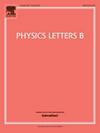A B−anomaly motivated Z′ boson at the energy and precision frontiers
IF 4.5
2区 物理与天体物理
Q1 ASTRONOMY & ASTROPHYSICS
引用次数: 0
Abstract
TeV-scale bosons with family-dependent couplings can explain some anomalies inferred from meson measurements of processes involving the transition. A originating from kinetically-mixed spontaneously broken gauge symmetry has been shown to greatly ameliorate global fits [1] in a ‘flavour-preferred’ region of parameter space. We provide an exploration of this region at the high luminosity (HL-)LHC with particular attention to which signals could be verified across different discovery modes. Even if the HL-LHC does not discover the boson in a resonant di-lepton channel, a FCC-ee -pole run would detect oblique corrections to the electroweak precision observables (EWPOs). Changes due to -induced non-oblique corrections are unlikely to be detected, to within experimental precision. In any case, the extended discovery potential offered by a 100 TeV collider would afford sensitivity to the entire flavour-preferred region and enable a fine-grained and forensic analysis of the model.
在能量和精度边界上,B−异常激发了Z’玻色子
具有族依赖耦合的tev尺度Z’玻色子可以解释从涉及B→s的过程的B -介子测量中推断出的一些异常。由动力学混合自发破断U(1)B3−L2规范对称产生的Z '已被证明可以极大地改善参数空间“风味偏好”区域的全局拟合[1]。我们在高亮度(HL-)大型强子对撞机上对该区域进行了探索,特别注意哪些信号可以在不同的发现模式下得到验证。即使HL-LHC没有在共振双轻子通道中发现Z’玻色子,FCC-ee的Z极运行也会检测到对电弱精度观测(EWPOs)的倾斜修正。由于Z '诱导的非斜校正引起的变化不太可能被检测到,在实验精度范围内。在任何情况下,100 TeV pp -对撞机提供的扩展发现潜力将提供对整个风味偏好区域的敏感性,并使模型的细粒度和法医分析成为可能。
本文章由计算机程序翻译,如有差异,请以英文原文为准。
求助全文
约1分钟内获得全文
求助全文
来源期刊

Physics Letters B
物理-物理:综合
CiteScore
9.10
自引率
6.80%
发文量
647
审稿时长
3 months
期刊介绍:
Physics Letters B ensures the rapid publication of important new results in particle physics, nuclear physics and cosmology. Specialized editors are responsible for contributions in experimental nuclear physics, theoretical nuclear physics, experimental high-energy physics, theoretical high-energy physics, and astrophysics.
 求助内容:
求助内容: 应助结果提醒方式:
应助结果提醒方式:


